PEAK SEASONS
Summer (June to August) is the peak season. Due to the volatile climate (refer to the interesting facts section for further details), summer is the most reliable time to visit. In fact, Going-to-the-Sun Road is closed during the winter.
Glacier National Park—the crown of the continent—lies to the north of the United States, in Montana’s Rocky Mountains. It is a World Heritage site[1], a biosphere reserve, the world’s first International Peace Park (alongside Waterton Lakes National Park), and an International Dark Sky park[2] (alongside places like the Grand Canyon National Park).
In this volatile yet pristine paradise, you can partake in a wide array of activities such as hiking, camping, backpacking, cycling, and wildlife viewing, among others. Most importantly, Glacier National Park has some of the best and most diverse hiking trails anywhere—many of them in perfectly shaded areas.
I enjoyed my time here tremendously. Most importantly, many of the best attractions can be visited in a relatively short span of time.
When you visit, make sure to follow this adventure guide to maximize your time in Glacier National Park.
Recommended Duration of Visit
2 days (ideal), 1 day (doable)
[1]: A World Heritage site is a landmark/area chosen by the United Nations Educational Scientific and Cultural Organisation (UNESCO) due to its scientific, cultural, or historical significance, among others. World Heritage Sites are considered important to the collective interests of humanity, and are, therefore, legally protected by international treaties.
[2] According to the International Dark Sky Organization, dark sky parks possess “an exceptional or distinguished quality of starry nights and a nocturnal environment that is specifically protected for its scientific, natural, educational, cultural heritage, and/or public enjoyment.”
Recommendations: Before Arriving
Recommendations: Adventure Gear
Click for some interesting facts about Glacier National Park
Summer (June to August) is the peak season. Due to the volatile climate (refer to the interesting facts section for further details), summer is the most reliable time to visit. In fact, Going-to-the-Sun Road is closed during the winter.
Established in 1910 as a national park and in 1932 as an International Peace Park.
Avalanche Lake, Going-to-the-Sun Road, and Trail of the Cedars, among others.
1583 miles2 (4100 kilometers2) of glacier-carved peaks, valleys, coniferous forest, prairie, tundra, lakes, and over 700 miles of hiking trails.
There are a variety of ranger-led programs in the summer. Refer to the park’s calendar for more information on certain dates.
If you do not have one, purchase the annual pass that grants access to any national park. You can buy it at any national park entrance.
Glacier National Park is very far from most cities, so make sure to prepare lodging months in advance. Lake McDonald Lodge and Many Glacier Hotel are within Glacier National Park.
Established in 1910 as a national park and in 1932 as an International Peace Park.
Summer (June to August) is the peak season. Due to the volatile climate (refer to the interesting facts section for further details), summer is the most reliable time to visit. In fact, Going-to-the-Sun Road is closed during the winter.
1583 miles2 (4100 kilometers2) of glacier-carved peaks, valleys, coniferous forest, prairie, tundra, lakes, and over 700 miles of hiking trails.
Avalanche Lake, Going-to-the-Sun Road, and Trail of the Cedars, among others.
If you do not have one, purchase the annual pass that grants access to any national park. You can buy it at any national park entrance.
Glacier National Park is very far from most cities, so make sure to prepare lodging months in advance. Lake McDonald Lodge and Many Glacier Hotel are within Glacier National Park.
There are a variety of ranger-led programs in the summer. Refer to the park’s calendar for more information on certain dates.
Ideal Method of Transportation
Driving a personal vehicle is, by far, the best way to get around Glacier National Park. Due to the unpredictable weather, a personal vehicle would also result in much more comfort and safety (since you can just stay in the vehicle). There are shuttles at the Apgar Visitor Center (stop #2).
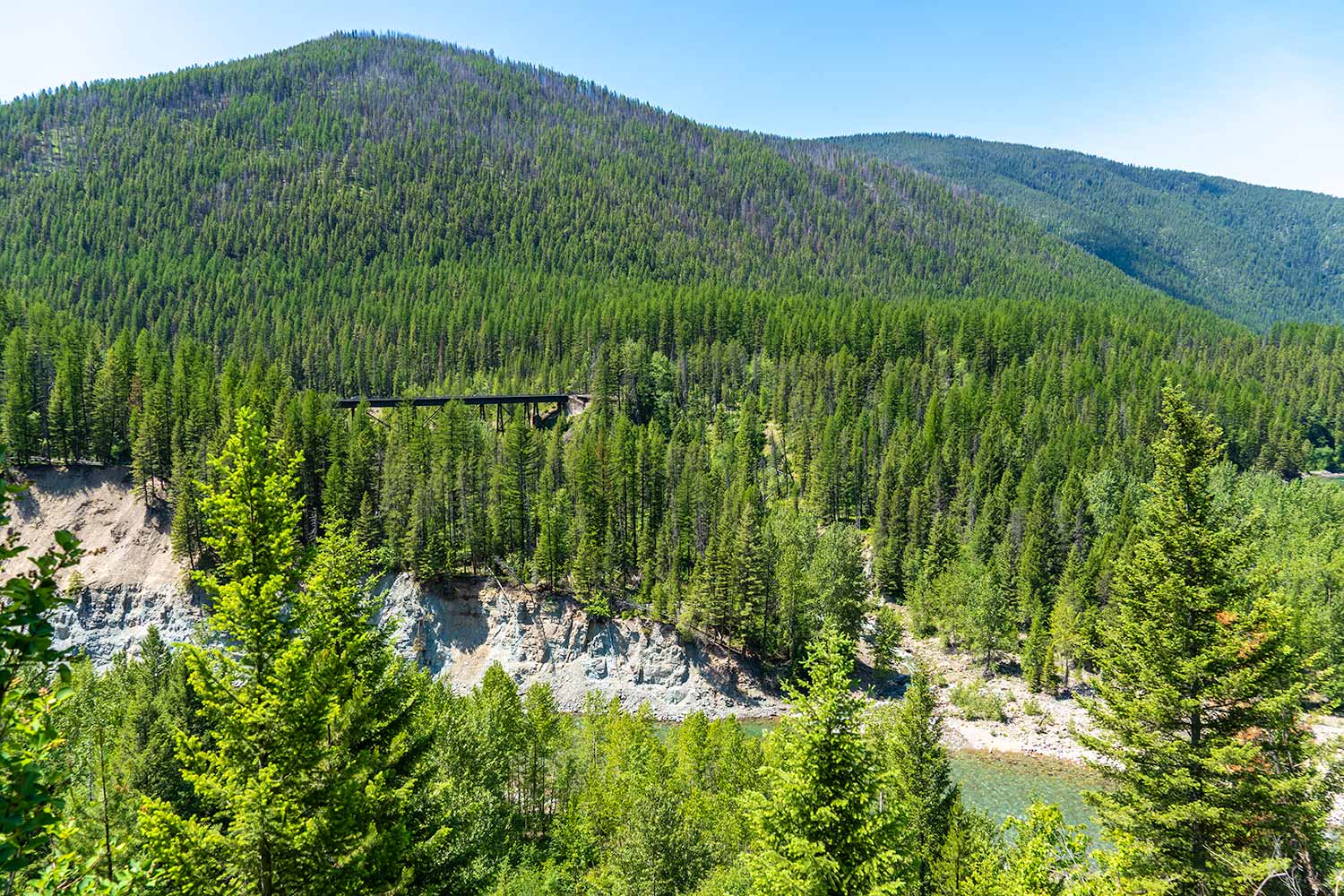 Goat Lick Overlook: The observation area, across from Highway 2, overlooks the riverbank of the Middle Fork Flathead River. Goats are drawn to the salts and minerals (potassium, calcium, sodium, magnesium, and phosphorus) found in the cliffs along the riverbank, and they would travel for miles because these are vital nutrients needed for optimal health. The goats are here most heavily from May to July, but can often be found from April through August.
Goat Lick Overlook: The observation area, across from Highway 2, overlooks the riverbank of the Middle Fork Flathead River. Goats are drawn to the salts and minerals (potassium, calcium, sodium, magnesium, and phosphorus) found in the cliffs along the riverbank, and they would travel for miles because these are vital nutrients needed for optimal health. The goats are here most heavily from May to July, but can often be found from April through August.
Cost: Free to visit. Recommended Duration of Visit: 30 – 60 minutes.
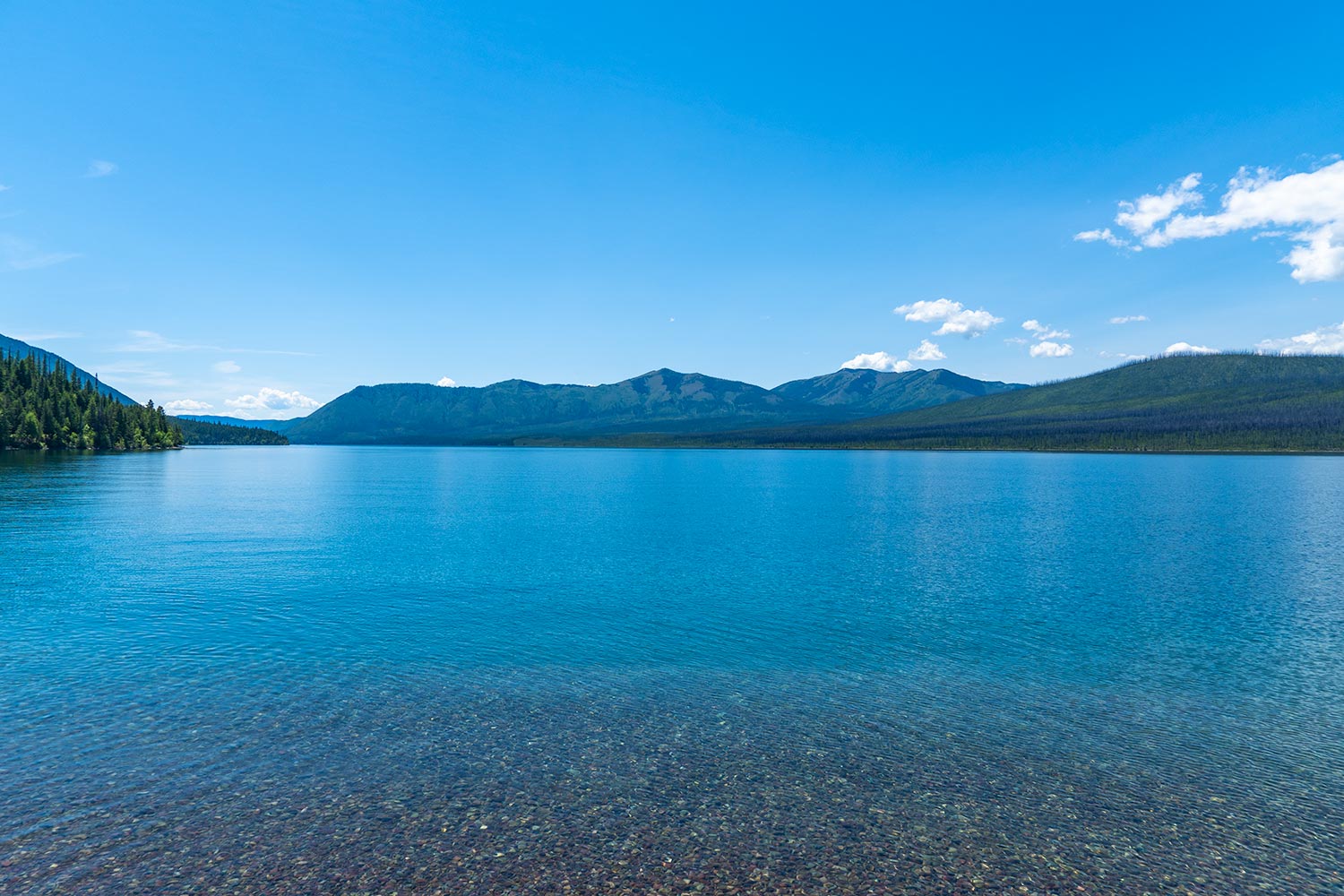 Lake McDonald: As the largest lake in Glacier National Park, Lake McDonald is approximately 10 miles (16 km) long and about a mile wide (1.6 km). This pristine lake is surrounded by gorgeous terrain comprised of trees, mountain peaks, and vibrant hills. Lake McDonald Lodge nearby is a viable lodging option as well.
Lake McDonald: As the largest lake in Glacier National Park, Lake McDonald is approximately 10 miles (16 km) long and about a mile wide (1.6 km). This pristine lake is surrounded by gorgeous terrain comprised of trees, mountain peaks, and vibrant hills. Lake McDonald Lodge nearby is a viable lodging option as well.
Cost: Free to visit. Recommended Duration of Visit: 1 – 2 hours.
| Bring binoculars or high optical zoom equipment for better views and pictures. The overlook also doubles as a nice rest stop with restrooms. Fun Fact: You can actually trick innocent bystanders into thinking that they can lick goats here. Their bemused looks are often hysterical. |
| Although trout (cutthroat, rainbow, and lake trout, among others) and other fish are commonly found within the lake, it is not considered a prime fishing spot (because it is nutrient-poor). During summers, the lake is a viable swimming spot. It’s too damn cold in the winter. |
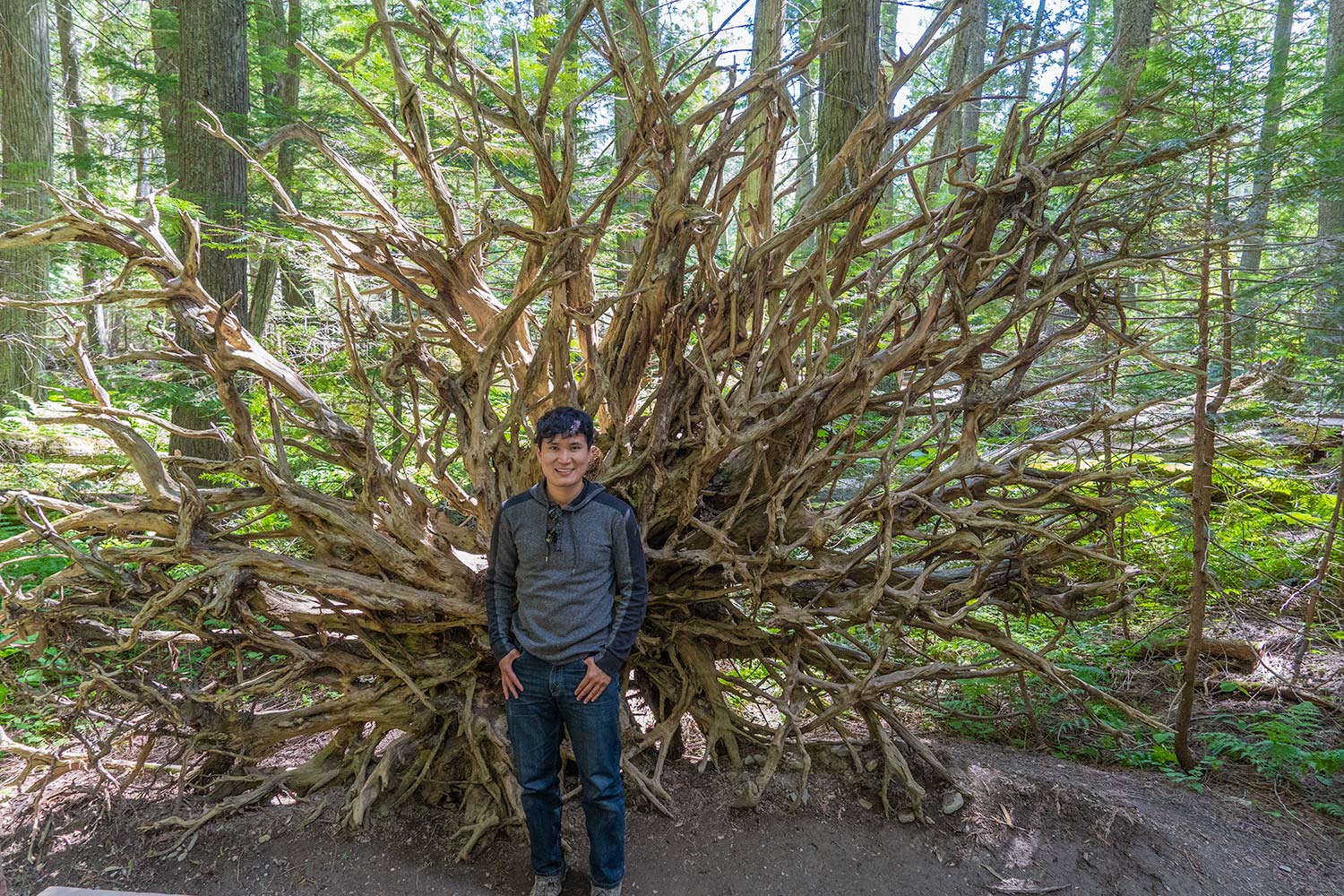 Trail of the Cedars: This hiking trail, located along Going-to-the-Sun Road, features a .7 mi (1.1 km) hiking loop and is wheelchair accessible. Its most unique feature is the fact that it’s not a conventional trail; it’s a raised boardwalk for most of the loop, and the remaining part is very well-maintained and flat. In addition to the cedars that are often over 80 feet (24 meters) tall, the trail also features a diverse landscape with rivers, wildlife, and a small waterfall at its midpoint.
Trail of the Cedars: This hiking trail, located along Going-to-the-Sun Road, features a .7 mi (1.1 km) hiking loop and is wheelchair accessible. Its most unique feature is the fact that it’s not a conventional trail; it’s a raised boardwalk for most of the loop, and the remaining part is very well-maintained and flat. In addition to the cedars that are often over 80 feet (24 meters) tall, the trail also features a diverse landscape with rivers, wildlife, and a small waterfall at its midpoint.
Cost: Free to visit. Recommended Duration of Visit: 1 – 2 hours.
 Avalanche Lake: Easily one of the most picturesque landscapes I’ve ever seen, Avalanche Lake—a glacially carved amphitheater—resembles a beautiful drawing of nature. While hiking 2 miles (3.2 km) one-way alongside gorgeous Avalanche Creek, you will encounter a diverse, vibrant, and stunning landscape that features multiple panoramic views and incredible photo opportunities. Unlike other phenomenal hikes throughout the United States (like Angel’s Landing in Zion National Park), this hike has an abundance of shade throughout.
Avalanche Lake: Easily one of the most picturesque landscapes I’ve ever seen, Avalanche Lake—a glacially carved amphitheater—resembles a beautiful drawing of nature. While hiking 2 miles (3.2 km) one-way alongside gorgeous Avalanche Creek, you will encounter a diverse, vibrant, and stunning landscape that features multiple panoramic views and incredible photo opportunities. Unlike other phenomenal hikes throughout the United States (like Angel’s Landing in Zion National Park), this hike has an abundance of shade throughout.
Cost: Free to visit. Recommended Duration of Visit: 3 – 4 hours (hike time included).
| Since the trail is in a loop, you need not worry which path to take. This trail also connects to Avalanche Trail—a separate trail leading to Avalanche Lake. There will be a sign indicating the diverging path to Avalanche Lake. There is also a trail nearby that leads you 5.6 miles (9 km) one-way to Lake McDonald. |
| Avalanche Lake has multiple trees on the water (excellent for photos). One such tree is located right in the middle of the lake. You might also have rare encounters with black bears and deer on your way to the lake. Although the bears are relatively harmless, maintain your distance just in case. |
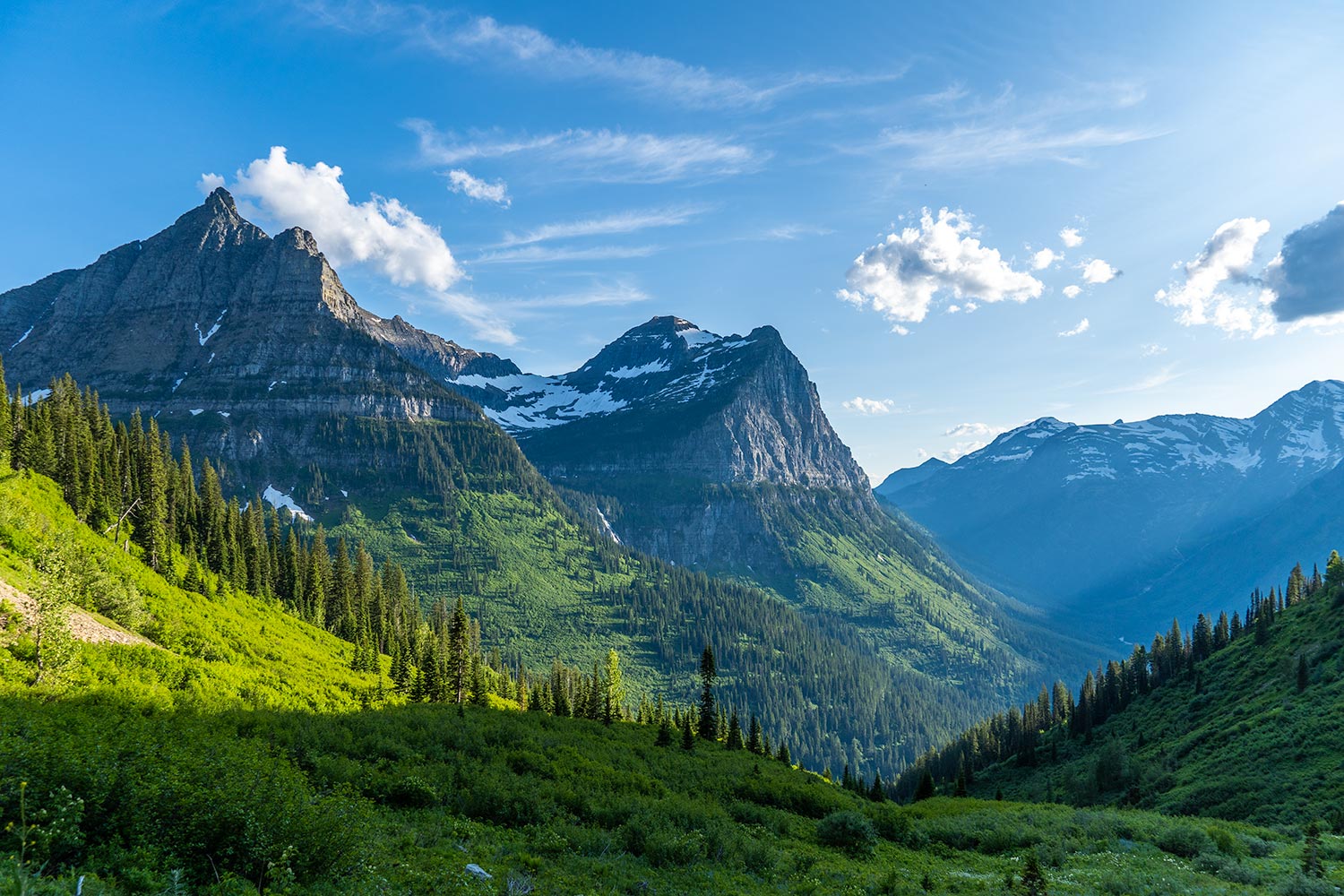 Going-to-the-Sun Road: As the most famous and easily-navigated attraction in Glacier National Park, this stunningly scenic road traverses the park and provides a breathtaking view of the peaks and valleys. The road is approximately 50 miles (80 km) long and spans the width of the park—connecting the west and east entrance stations. The best views emerge once you pass the Trail of the Cedars/Avalanche Lake area.
Going-to-the-Sun Road: As the most famous and easily-navigated attraction in Glacier National Park, this stunningly scenic road traverses the park and provides a breathtaking view of the peaks and valleys. The road is approximately 50 miles (80 km) long and spans the width of the park—connecting the west and east entrance stations. The best views emerge once you pass the Trail of the Cedars/Avalanche Lake area.
Cost: Free to visit. Recommended Duration of Visit: 1 – 2 hours.
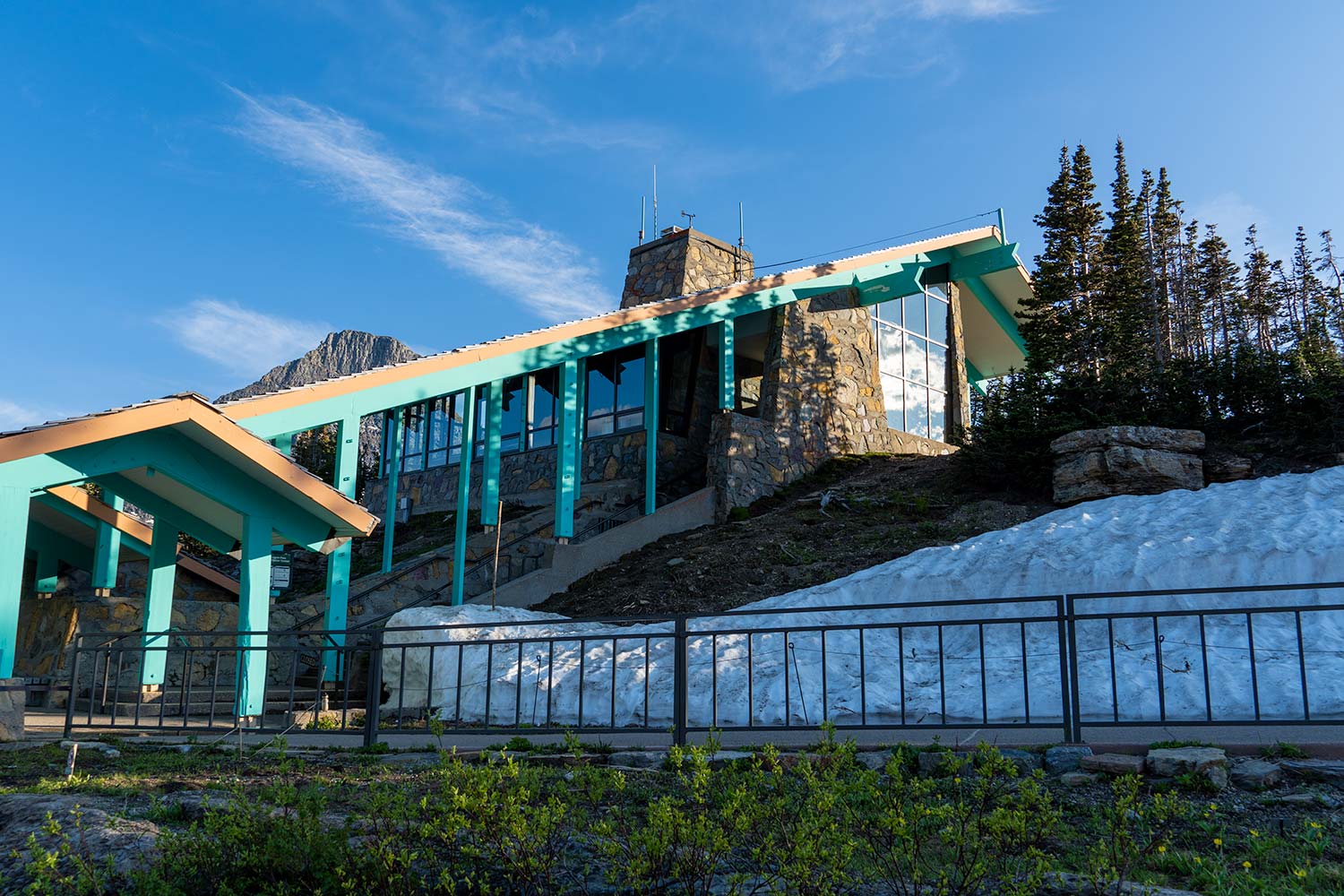 Logan Pass Visitor Center: Situated right next to Logan Pass and the Continental Divide, Logan Pass Visitor Center lies at the summit of Going-to-the-Sun Road. This information center is an excellent rest stop and vantage point (Logan Pass is the highest point on Going-to-the-Sun Road after all). Directly behind the center is the Hidden Lake Nature Trail—a hiking trail leading to a beautiful lake that’s larger than Avalanche Lake.
Logan Pass Visitor Center: Situated right next to Logan Pass and the Continental Divide, Logan Pass Visitor Center lies at the summit of Going-to-the-Sun Road. This information center is an excellent rest stop and vantage point (Logan Pass is the highest point on Going-to-the-Sun Road after all). Directly behind the center is the Hidden Lake Nature Trail—a hiking trail leading to a beautiful lake that’s larger than Avalanche Lake.
Cost: Free to visit. Recommended Duration of Visit: 30 – 60 minutes.
| For the best possible route and view, make sure to follow the route information in the Logistics section. Going-to-the-Sun Road is usually open from early June to mid October and is closed during winters (because it is one of the most difficult roads to snow plow in the entire country). |
| Logan Pass closes at 7 pm (the same time as the over visitor centers). The St Mary’s Visitor Center lies all the way to the right entrance of the park while the Apgar Visitor Center lies all the way to left. Logan Pass is the perfect rest stop situated right in the middle. |
 Goat Lick Overlook: The observation area, across from Highway 2, overlooks the riverbank of the Middle Fork Flathead River. Goats are drawn to the salts and minerals (potassium, calcium, sodium, magnesium, and phosphorus) found in the cliffs along the riverbank, and they would travel for miles because these are vital nutrients needed for optimal health. The goats are here most heavily from May to July, but can often be found from April through August.
Goat Lick Overlook: The observation area, across from Highway 2, overlooks the riverbank of the Middle Fork Flathead River. Goats are drawn to the salts and minerals (potassium, calcium, sodium, magnesium, and phosphorus) found in the cliffs along the riverbank, and they would travel for miles because these are vital nutrients needed for optimal health. The goats are here most heavily from May to July, but can often be found from April through August.
Cost: Free to visit. Recommended Duration of Visit: 30 – 60 minutes.
| Bring binoculars or high optical zoom equipment for better views and pictures. The overlook also doubles as a nice rest stop with restrooms. Fun Fact: You can actually trick innocent bystanders into thinking that they can lick goats here. Their bemused looks are often hysterical. |
 Lake McDonald: As the largest lake in Glacier National Park, Lake McDonald is approximately 10 miles (16 km) long and about a mile wide (1.6 km). This pristine lake is surrounded by gorgeous terrain comprised of trees, mountain peaks, and vibrant hills. Lake McDonald Lodge nearby is a viable lodging option as well.
Lake McDonald: As the largest lake in Glacier National Park, Lake McDonald is approximately 10 miles (16 km) long and about a mile wide (1.6 km). This pristine lake is surrounded by gorgeous terrain comprised of trees, mountain peaks, and vibrant hills. Lake McDonald Lodge nearby is a viable lodging option as well.
Cost: Free to visit. Recommended Duration of Visit: 1 – 2 hours.
| Although trout (cutthroat, rainbow, and lake trout, among others) and other fish are commonly found within the lake, it is not considered a prime fishing spot (because it is nutrient-poor). During summers, the lake is a viable swimming spot. It’s too damn cold in the winter. |
 Trail of the Cedars: This hiking trail, located along Going-to-the-Sun Road, features a .7 mi (1.1 km) hiking loop and is wheelchair accessible. Its most unique feature is the fact that it’s not a conventional trail; it’s a raised boardwalk for most of the loop, and the remaining part is very well-maintained and flat. In addition to the cedars that are often over 80 feet (24 meters) tall, the trail also features a diverse landscape with rivers, wildlife, and a small waterfall at its midpoint.
Trail of the Cedars: This hiking trail, located along Going-to-the-Sun Road, features a .7 mi (1.1 km) hiking loop and is wheelchair accessible. Its most unique feature is the fact that it’s not a conventional trail; it’s a raised boardwalk for most of the loop, and the remaining part is very well-maintained and flat. In addition to the cedars that are often over 80 feet (24 meters) tall, the trail also features a diverse landscape with rivers, wildlife, and a small waterfall at its midpoint.
Cost: Free to visit. Recommended Duration of Visit: 1 – 2 hours.
| Since the trail is in a loop, you need not worry which path to take. This trail also connects to Avalanche Trail—a separate trail leading to Avalanche Lake. There will be a sign indicating the diverging path to Avalanche Lake. There is also a trail nearby that leads you 5.6 miles (9 km) one-way to Lake McDonald. |
 Avalanche Lake: Easily one of the most picturesque landscapes I’ve ever seen, Avalanche Lake resembles a beautiful drawing of nature. While hiking 2 miles (3.2. km) one-way alongside gorgeous Avalanche Creek, you will encounter a diverse, vibrant, and stunning landscape that features multiple panoramic views and incredible photo opportunities. Unlike other phenomenal hikes throughout the United States (like Angel’s Landing in Zion National Park), this hike has an abundance of shade throughout.
Avalanche Lake: Easily one of the most picturesque landscapes I’ve ever seen, Avalanche Lake resembles a beautiful drawing of nature. While hiking 2 miles (3.2. km) one-way alongside gorgeous Avalanche Creek, you will encounter a diverse, vibrant, and stunning landscape that features multiple panoramic views and incredible photo opportunities. Unlike other phenomenal hikes throughout the United States (like Angel’s Landing in Zion National Park), this hike has an abundance of shade throughout.
Cost: Free to visit. Recommended Duration of Visit: 3 – 4 hours (hike time included).
| Avalanche Lake has multiple trees on the water (excellent for photos). One such tree is located right in the middle of the lake. You might also have rare encounters with black bears and deer on your way to the lake. Although the bears are relatively harmless, maintain your distance just in case. |
 Going-to-the-Sun Road: As the most famous and easily-navigated attraction in Glacier National Park, this stunningly scenic road traverses the park and provides a breathtaking view of the peaks and valleys. The road is approximately 50 miles (80 km) long and spans the width of the park—connecting the west and east entrance stations. The best views emerge once you pass the Trail of the Cedars/Avalanche Lake area.
Going-to-the-Sun Road: As the most famous and easily-navigated attraction in Glacier National Park, this stunningly scenic road traverses the park and provides a breathtaking view of the peaks and valleys. The road is approximately 50 miles (80 km) long and spans the width of the park—connecting the west and east entrance stations. The best views emerge once you pass the Trail of the Cedars/Avalanche Lake area.
Cost: Free to visit. Recommended Duration of Visit: 1 – 2 hours.
| For the best possible route and view, make sure to follow the route information in the Logistics section. Going-to-the-Sun Road is usually open from early June to mid October and is closed during winters (because it is one of the most difficult roads to snow plow in the entire country). |
 Logan Pass Visitor Center: Situated right next to Logan Pass and the Continental Divide, Logan Pass Visitor Center lies at the summit of Going-to-the-Sun Road. This information center is an excellent rest stop and vantage point (Logan Pass is the highest point on Going-to-the-Sun Road after all). Directly behind the center is the Hidden Lake Nature Trail—a hiking trail leading to a beautiful lake that’s larger than Avalanche Lake.
Logan Pass Visitor Center: Situated right next to Logan Pass and the Continental Divide, Logan Pass Visitor Center lies at the summit of Going-to-the-Sun Road. This information center is an excellent rest stop and vantage point (Logan Pass is the highest point on Going-to-the-Sun Road after all). Directly behind the center is the Hidden Lake Nature Trail—a hiking trail leading to a beautiful lake that’s larger than Avalanche Lake.
Cost: Free to visit. Recommended Duration of Visit: 30 – 60 minutes.
| Logan Pass closes at 7 pm (the same time as the over visitor centers). The St Mary’s Visitor Center lies all the way to the right entrance of the park while the Apgar Visitor Center lies all the way to left. Logan Pass is the perfect rest stop situated right in the middle. |
Wild at heart
WILDLIFE VIEWING: Partake in a unique wildlife viewing experience.
| PRO TIP: Remember to properly distance yourself from the various forms of wildlife. In general, animals are most easily spotted during the early mornings (8 to 10 am) or early evenings (4 to 6 pm) when temperatures are cooler. However, Goat Lick Overlook tends to consistently have goats throughout the day. Always ensure that either you or someone else is watching your back. This park has an abundance of animals that can impale or ram you(i.e. goats). | COST: Nothing or Everything (if the animals attack). | |
Even though they’re sheepish most of the time, goats do charge at people or vehicles if provoked. If you want to be in the photo, keep a safe distance and do not surprise them. Make light noises so the goats know you’re there.
Below are a map and schedule—the same one I followed during my time in Glacier National Park. Both will be good references for all your activity planning needs. I’ve also included a link for a larger PDF version of the Glacier National Park map.
More information on Rising Sun Pizza
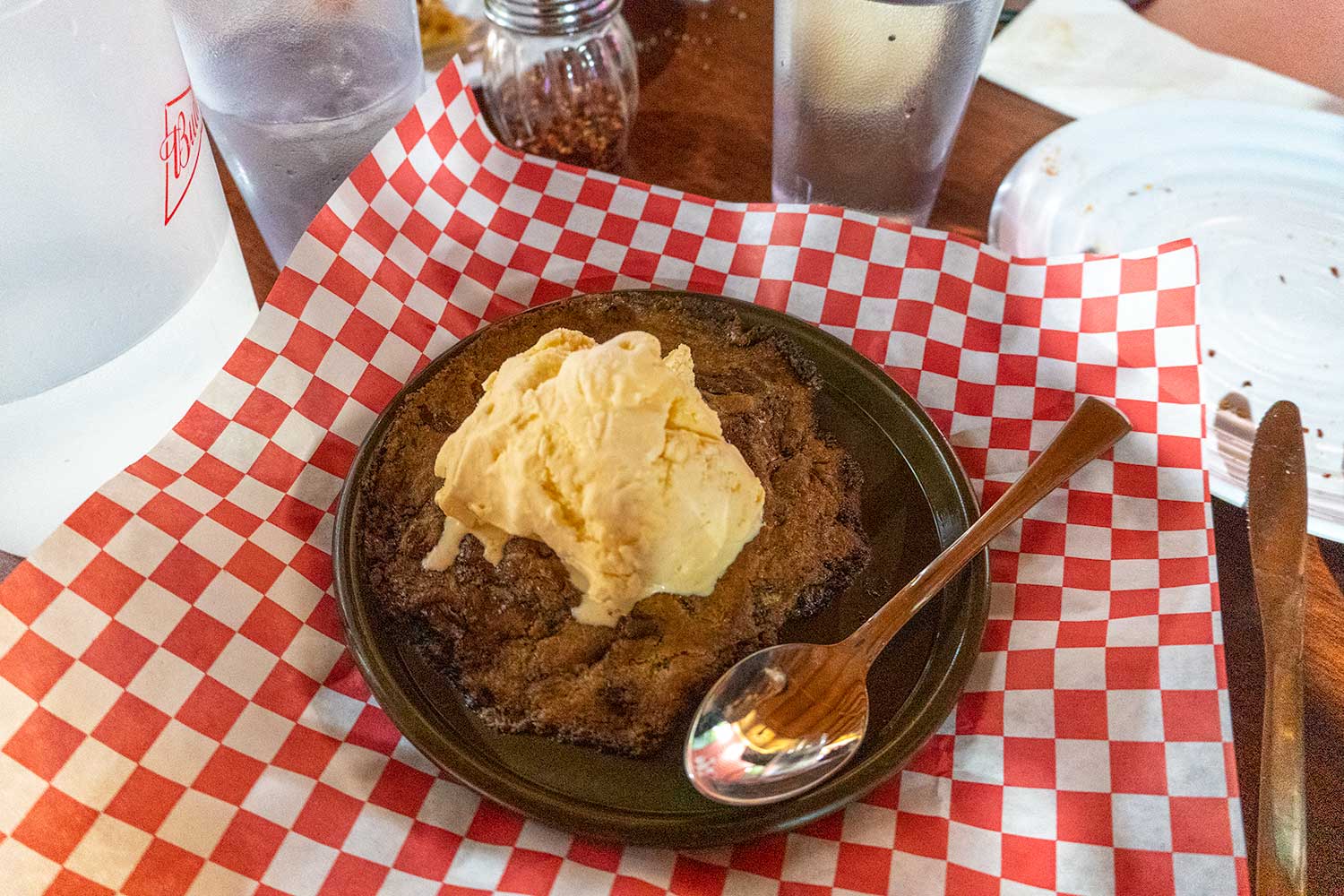
What to order: I recommend the Rising Wolf and Supreme Summit. You can get two flavors and split your pizza into two distinct halves. For dessert, get the Pizookie.
Compared to many other national parks in the United States, the crown of the continent features some of the most picturesque, low commitment, and easy-to-visit attractions around. As an added bonus, Some of the best attractions in Glacier National Park can be visited within one or two days. If you’re in the area, be sure to visit this underrated gem.
On a final note, make sure to share this page so others will know more about Glacier National Park!